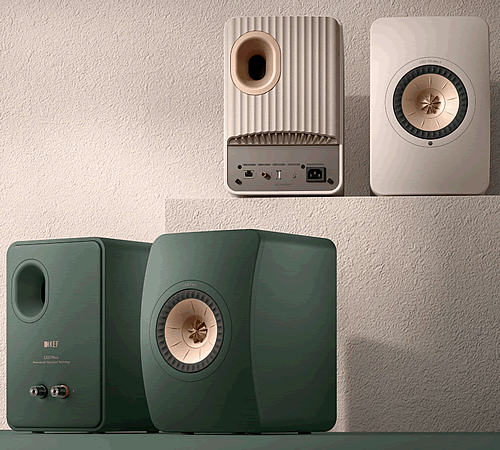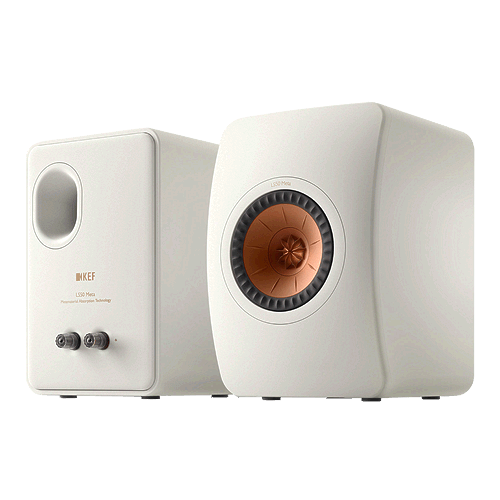 @kemela
@kemela
KEF manufactures low distortion high value loudspeakers with a long history of innovation including the Uni-Q driver™ and meta materials
KEF is a leading manufacturer of in-wall and box loudspeakers with a wide global distribution with a philosophy for high fidelity sound reproduction based on generating dynamic, low distortion, wide frequency sound that is faithful to the source without drama, exaggeration or artifice. Products are designed in KEF's UK research facilities, while drivers are manufactured in Asia.
Uni-Q™ Coaxial Driver
The development of powerful neodymium based magnetic materials in the late 1980s (first developed by NASA) allowed tweeter magnets to be small enough to locate the tweeter coaxially within a mid/bass driver rather than next to it. KEF was an early pioneer of coaxial designs as low mid to high frequencies could now originate from one place; a "point source" with a wider even distribution without 'lobing' and a broader "sweet spot". Within the sound stage focus and localization are more precise with greater sense of space around musicians performing in their in their own space.

Meta material technology
Metamaterial Absorption Technology (MAT™) is a new approach to dealing with the complex issue of the fate of sound eminating from the rear of the UNI-Q™ driver. The idea of Metamaterial Absorption Technology is essentially to prevent the energy from the rear of the driver from undergoing multiple reflections that would otherwise bounce back and spoil how the driver is reacting in response to the signal fed to it. Unwanted energy - particularly if it is resonant in nature (which tends to prolong and amplifiy specific frequencies inducing sound "coloration") - is dissipated by a maze of tuned channels.
Powered Wireless Speakers
KEF's LS series of powered speakers are an excellent solution for those wanting to keep things simple and don't require the upgrade possibility of a sytem built of seaprate components. They ferature built-in mulitple amplifiers, a high resolution DAC with streaming ability and KEF's DSP technology to optimize crossover timing and provide environmental control taking into account speaker placement, room sound characteristics, and listening distance - a little more sophisticated than old school tone controls or parametric equalization.

KEF LS50 Meta Speakers
- Two-way bass-reflex single-wired bookshelf speaker with 5.25" bass/mid with 1.0" concentric tweeter Uni-Q driver with Metamaterial and CFD ports
- Frequency response is 47Hz-45kHz (-6dB); 79Hz-28kHz (±3dB); Max output is 106dB
- Sensitivity is 85 dB and the recommended amplifier is 40-100 watts, nominal impedance is 8Ω (min 3.5Ω);
- 11.9" x 7.8" x 11.0" (HWD)
- Weight: 17.2 lbs
- Carbon black, mineral white, titanium grey, moss green (new) and sand shell (new) finishes
KEF LS50 Wireless II Speakers
- Two-way bass-reflex active bookshelf speaker with 5.25" bass/mid driver powered by 280 watt amplifer and 1.0" concentric tweeter powered by 100 watt amplifer. Features 'Metamaterial' resonance control, CFD ports, touch sensitive control panel, remote control, and app. Adjustable frequency response for flexible placement and there is a subwoofer output
- Frequency response is 43Hz-45kHz (-6dB); 48Hz-28kHz (±3dB); Max output is 108dB
- Inputs are: 3.5mm Analog, Bluetooth 4.2 with aptX® codec, Coax Digital (24bit/192kHz), TOSLINK Optical (24bit/96kHz), HDMI eARC 10/100 Mbps RJ45 Ethernet (For network and service), 2.4GHz/5GHz Dual-band Wi-Fi network
- 12.0" x 7.9" x 12.2" (HWD)
- Weight: 22.5 lbs
- Carbon black, mineral white, and titanium grey finishes
KEF LS60 Meta Speakers
- Elegant active floorstanding speaker with pair of side mounted opposing 5.25" bass drivers powered by 500 watt amplifer, 4.0" Uni-Q midrange with 0.75" concentric tweeter powered by 100 watt amplifers. Features 'Metamaterial' resonance control, CFD ports, touch sensitive control panel, remote control, and app. Adjustable frequency response for flexible placement and there is a subwoofer output
- Frequency response is 26Hz-36kHz (-6dB); 31Hz-24kHz (±3dB); Max output is 111dB
- Inputs are: 3.5mm Analog, Bluetooth 4.2 with aptX® codec, Coax Digital (24bit/192kHz), TOSLINK Optical (24bit/96kHz), HDMI eARC 10/100 Mbps RJ45 Ethernet (For network and service), 2.4GHz/5gHz Dual-band Wi-Fi network
- 41" x 5.1" x 12.6" (HWD), 43" x 8.3" x 15.5" (w/ plinth)
- Weight: 70 lbs each
- Titanium Grey, Mineral White, and Royal Blue finishes
KEF R3 Meta Stand Mount Speakers
- Three-way bass-reflex bi-wired stand mount speaker with 6.5" bass/mid with 1.0" concentric tweeter Uni-Q driver with Metamaterial and CFD ports
- Frequency response is 38Hz-50kHz (-6dB); 58Hz-28kHz (±3dB); Max output is 110dB
- Sensitivity is 87 dB and the recommended amplifier is 15-180 watts, nominal impedance is 8Ω (min 3.2Ω);
- 16.6" x 7.9" x 13.2" (HWD)
- Weight: 29.8 lbs
- Gloss Black, Gloss White and Walnut finishes
KEF R5 Meta Floor Standing Speakers
- Three-way bass-reflex bi-wired stand mount speaker with two 5.25" bass drivers and 5" midrange with 1.0" concentric tweeter Uni-Q driver with Metamaterial and CFD ports
- Frequency response is 38Hz-50kHz (-6dB); 52Hz-28kHz (±3dB); Max output is 110dB
- Sensitivity is 87 dB and the recommended amplifier is 15-200 watts, nominal impedance is 8Ω (min 3.2Ω);
- 40.4" x 6.9" x 13.5" (without plinth)
- weight: 60.2 lbs
- Gloss Black, Gloss White and Walnut finishes
KEF R7 Meta Floor Standing Speakers
- Three-way bass-reflex bi-wired stand mount speaker with two 6.5" bass drivers and 5" midrange with 1.0" concentric tweeter Uni-Q driver with Metamaterial and CFD ports
- Frequency response is 33Hz-50kHz (-6dB); 48Hz-28kHz (±3dB); Max output is 111dB
- Sensitivity is 88 dB and the recommended amplifier is 15-250 watts, nominal impedance is 8Ω (min 3.2Ω);
- 41.8" x 7.9" x 15.1" (without plinth)
- Weight: 69.2 lbs
- Gloss Black, Gloss White and Walnut finishes
KEF R11 Meta Floor Standing Speakers
- Three-way bass-reflex bi-wired stand mount speaker with four 6.5" bass drivers and 5" midrange with 1.0" concentric tweeter Uni-Q driver with Metamaterial and CFD ports
- Frequency response is 30Hz-50kHz (-6dB); 46Hz-28kHz (±3dB); Max output is 113dB
- Sensitivity is 90 dB and the recommended amplifier is 15-300 watts, nominal impedance is 8Ω (min 3.7Ω);
- 49.2" x 7.9" x 15.1" (without plinth)
- Weight: 83.1 lbs
- Gloss Black, Gloss White and Walnut finishes
KEF R2c Meta Center Speaker
- Three-way closed box bi-wired center speaker with two 5.25" bass drivers and 5" midrange with 1.0" concentric tweeter Uni-Q driver with Metamaterial and CFD ports
- Frequency response is 64Hz-50kHz (-6dB); 74Hz-28kHz (±3dB); Max output is 110dB
- Sensitivity is 87 dB and the recommended amplifier is 15-200 watts, nominal impedance is 8Ω (min 3.2Ω);
- 6.9" x 21.7" x 12.1" (HWD)
- Weight: 37.3 lbs
- Gloss Black, Gloss White and Walnut finishes
KEF R8a Meta Atmos
- For 3D sound image that Dolby Atmos creates
- Two-way closed box bi-wired center speaker with5" midrange with 1.0" concentric tweeter Uni-Q driver with Metamaterial and CFD ports
- Frequency response is 96Hz-19.5kHz (-6dB); 105Hz-18.5kHz (±3dB); Max output is 106dB
- Sensitivity is 86 dB and the recommended amplifier is 25-150 watts, nominal impedance is 8Ω (min 4.8Ω);
- 6.8" x 6.9" x 10.2" (HWD)
- Weight: 9.8 lbs
- Gloss Black or Gloss White finishes
KEF Reference 1 Meta Speakers
- Three-way bass-reflex bi-wired stand mount speaker with a 6.5" low distortion bass drive and 5" midrange with 1.0" concentric tweeter Uni-Q driver with Metamaterial and CFD ports
- Frequency response is 45Hz-35kHz (-6dB); 37Hz-40kHz (±3dB); typical in room bass extension 30Hz; Max output is 111dB
- Harmonic Distortion: 40Hz-100kHz less than 0.5%, 200Hz-10kHz less than 0.2%
- Sensitivity is 85 dB and the recommended amplifier is 50-200 watts, nominal impedance is 8Ω (min 4.2Ω);
- Tunable port three-way bass reflex design, hand built by KEF in the UK
- 17.3" x 8.1" x 16.6" (HWD)
- Weight: 40.1 lbs
- Standard finishes: Deep piano black, Satin american walnut. Delivery time varies according to finish.
- More information on The Reference Loudspeakers
KEF Reference 3 Meta Speakers
- Three-way bass-reflex bi-wired floor standing speaker with four 6.5" low distortion bass drivers and 5" midrange with 1.0" concentric tweeter Uni-Q driver with Metamaterial and CFD ports
- Frequency response is 40Hz-35kHz (-6dB); 32Hz-35kHz (±3dB); typical in room bass extension 25Hz; Max output is 116dB
- Harmonic Distortion: 40Hz-100kHz less than 0.5%, 200Hz-10kHz less than 0.2%
- Sensitivity is 88 dB and the recommended amplifier is 50-400 watts, nominal impedance is 8Ω (min 3.2Ω);
- Tunable port three-way bass reflex design, hand built by KEF in the UK
- 47.3" x 8.0" x 18.2" (without plinth)
- Weight: 132.7 lbs
- Standard finishes: Deep piano black, Satin american walnut, Luxury gloss rosewood. Delivery time varies according to finish.
- Kent Foundary finishes: Blue Ice White, Copper Aluminum Black
- More information on The Reference Loudspeakers
KEF Reference 5 Meta Speakers
- Three-way bass-reflex bi-wired floor standing speaker with four 6.5" low distortion bass drivers and 5" midrange with 1.0" concentric tweeter Uni-Q driver with Metamaterial and CFD ports
- Frequency response is 40Hz-35kHz (-6dB); 32Hz-35kHz (±3dB); typical in room bass extension 25Hz; Max output is 116dB
- Harmonic Distortion: 40Hz-100kHz less than 0.5%, 200Hz-10kHz less than 0.2%
- Sensitivity is 88 dB and the recommended amplifier is 50-400 watts, nominal impedance is 8Ω (min 3.2Ω);
- Tunable port three-way bass reflex design, hand built by KEF in the UK
- 47.3" x 8.0" x 18.2" (without plinth)
- Weight: 132.7 lbs
- Standard finishes: Deep piano black, Satin american walnut, Luxury gloss rosewood. Delivery time varies according to finish.
- Kent Foundary finishes: Blue Ice White, Copper Aluminum Black
- More information on The Reference Loudspeakers
KEF BLADE 2 Meta Speakers
- Three-way bass-reflex bi-wired floor standing speaker with four 6.5" low distortion bass drivers and 5" midrange with 1.0" concentric tweeter Uni-Q driver with Metamaterial and CFD ports
- Frequency response is 34Hz-45kHz (-6dB); 40Hz-35kHz (±3dB); Max output is 116dB
- Harmonic Distortion: 40Hz-100kHz less than 0.5%, 200Hz-10kHz less than 0.2%
- Sensitivity is 90 dB and the recommended amplifier is 50-400 watts, nominal impedance is 4Ω (min 3.2Ω);
- Tunable port three-way bass reflex design, hand built by KEF in the UK
- 57.5" x 13.3" x 18.7" (HWD)
- Weight: 77.8 lbs
- Gloss diamond black, gloss white, or custom colors
- More information on Blade Loudspeakers
KEF BLADE Meta Speakers
- Three-way bass-reflex bi-wired floor standing speaker with four 9" low distortion bass drivers and 5" midrange with 1.0" concentric tweeter Uni-Q driver with Metamaterial and CFD ports
- Frequency response is 28Hz-45kHz (-6dB); 40Hz-28kHz (±3dB); Max output is 117dB
- Harmonic Distortion: 40Hz-100kHz less than 0.5%, 200Hz-10kHz less than 0.2%
- Sensitivity is 90 dB and the recommended amplifier is 50-400 watts, nominal impedance is 4Ω (min 3.2Ω);
- Tunable port three-way bass reflex design, hand built by KEF in the UK
- 62.5" x 14.3" x 21.2" (HWD)
- Weight: 126 lbs
- Gloss diamond black, gloss white, or custom colors
- More information on Blade Loudspeakers
KEF Ventura Outdoor Speakers
- Rugged outdoor speakers made of durable UV resistant, high impact composite, powder-coated aluminum grilles & brackets. IP65 certified as dust tight and salt spray resistant. Outdoor operating temperatures -40 to 158 degrees Farenheit
- Three models with 4.5, 5.25, and 6.5 inch woofers and corresponding 80 to 125 watts power handling depending on model
- Available in white and black finishes